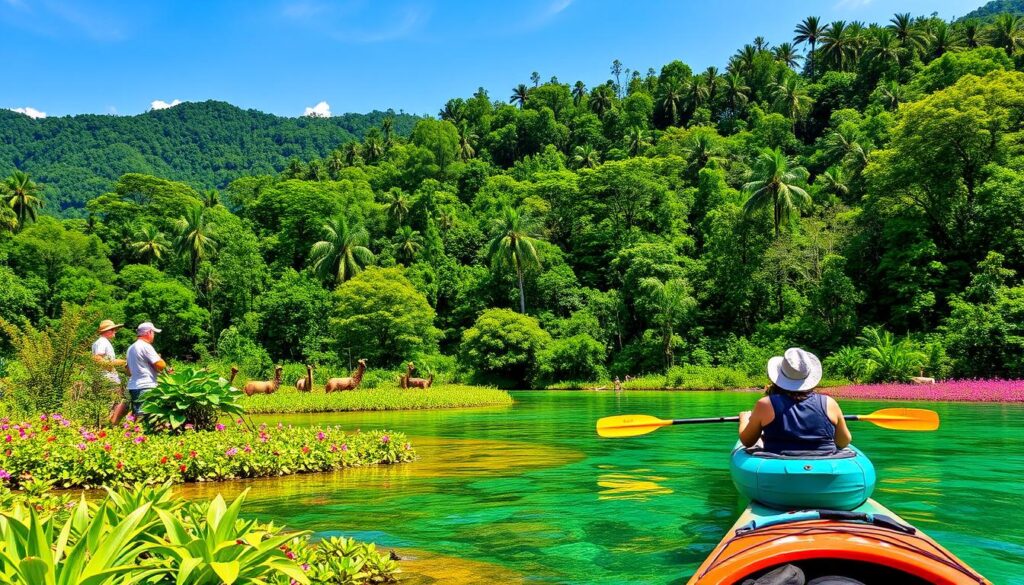Imagine being in a lush forest, surrounded by wildlife. You know your visit helps protect nature. This is what responsible wildlife tourism is all about. It’s about having amazing experiences while helping animals and the environment.
Groups like the Sheldrick Wildlife Trust and the National Kiwi Hatchery help make this happen. They focus on animal care and saving the planet. This way, you can join a movement that cares deeply about the world.
On your journey, you’ll see amazing things. You might watch elephants in the wild or help save endangered animals. By picking the right tour operators, you help protect our planet’s wildlife and nature.
Key Takeaways
- Responsible wildlife tourism supports conservation efforts and protects biodiversity
- Ethical wildlife experiences prioritize animal welfare and environmental conservation
- Sustainable wildlife encounters can be found in various destinations around the world
- Supporting responsible animal tourism can contribute to the preservation of natural environments
- Choosing ethical wildlife tour operators is crucial for a guilt-free adventure
- Conservation projects and wildlife sanctuaries play a vital role in protecting endangered species
By choosing responsible wildlife tourism, you’ll have an adventure that matters. You’ll be part of a movement that helps the world. So, start planning your next wildlife adventure today. It’s a chance to explore, conserve, and have fun all at once.
Understanding Ethical Wildlife Experiences
When we go on wildlife conservation trips, we must think about how we affect the environment and animals. Eco-conscious wildlife tours let us see animals in their homes while helping the planet. By picking ethical animal encounters, we help protect species and support local people.
Places like Kruger National Park in South Africa and Dana Point in North America are great examples. They let animals live freely and protect marine life. These spots show a big commitment to keeping wildlife safe and giving us chances for ethical wildlife experiences.
To have a good effect, we should choose wildlife conservation trips that care about animal well-being. We should watch wildlife from far away and not touch them. By making smart choices, we help animals live freely and naturally.
In the end, wildlife conservation trips and eco-conscious wildlife tours are great ways to connect with nature. By picking ethical animal encounters, we help the planet and support local communities. This way, we ensure a better future for all.
Benefits of Ethical Wildlife Experiences
Choosing sustainable wildlife encounters and eco-friendly tourism has big benefits. It helps the environment and local communities a lot. By picking responsible travel, you help save biodiversity and support local people.
Research shows that wildlife tourism is key for eco-friendly travel. It helps protect nature and support conservation worldwide.
Environmental Conservation
One big plus of ethical wildlife experiences is saving the environment. Sustainable tourism lets travelers lower their carbon footprint and aid conservation. Activities like wildlife safaris help protect animals and their homes.
Support for Local Communities
Responsible travel also helps local communities. It lets them earn from tourism while keeping their culture alive. Eco-friendly tourism creates jobs and boosts the local economy.
By choosing sustainable wildlife encounters, you help local people and the planet. This promotes green practices and reduces harm to the environment.
Some main benefits of eco-friendly tourism and responsible travel are:
- Promoting environmental conservation and biodiversity protection
- Supporting local communities and contributing to their economic growth
- Encouraging sustainable practices and reducing carbon footprint
Choosing Ethical Wildlife Tour Providers
When planning a wildlife adventure, picking a responsible tour operator is key. They should care about animal welfare and travel sustainably. It’s important to research their certifications and standards. Look for reputable organizations like the Global Federation of Animal Sanctuaries. Also, check if they are open about their practices and policies.
More people now want to travel in a way that helps animals and nature. About 71% of travelers look for wildlife experiences that support conservation and animal welfare. By choosing a responsible tour operator, you help protect species and support local communities.
Researching Certifications and Standards
- Check for certifications from reputable organizations, such as the Global Federation of Animal Sanctuaries
- Research the tour operator’s policies and practices, including their approach to animal welfare and conservation
- Look for transparency in their operations, including information on their website and social media channels
By choosing a responsible wildlife tour operator, you make a positive difference. You support the environment and local communities. Plus, you get to enjoy a unique and enriching wildlife experience. Sustainable travel is good for the planet and supports eco-conscious tourism.
Types of Ethical Wildlife Experiences
There are many ways to enjoy wildlife ethically. You can go on wildlife safaris or whale watching. These activities let you see animals in their homes. They also help protect animals and support eco-tourism.
Wildlife safaris help protect animals and their homes. For example, the David Sheldrick Wildlife Trust in Kenya has helped over 150 orphaned elephants. They were raised by hand and now live in wild herds.
Whale watching is another great choice. Places like Deep Sea Divers Den in Queensland let you see dwarf minke whales up close. They do it in a way that doesn’t harm the whales, supporting eco-tourism.
Choosing wildlife safaris and whale watching helps animals and their homes. It also supports eco-tourism and responsible travel.
The Role of Wildlife Sanctuaries
Wildlife sanctuaries are key in saving nature and protecting different species. They give a safe place for rescued animals to live and grow. By helping these sanctuaries, we support conservation and responsible tourism.
Wildlife sanctuaries do many important things:
- They give a safe and natural home for rescued animals.
- They help endangered species by breeding them in safe places.
- They teach people about the need to protect nature.
Visiting wildlife sanctuaries should be done with care. We should respect the animals and their homes. We should not touch or hold them. Supporting places that care for animals and nature is important. This way, we help show the value of wildlife sanctuaries in saving nature and responsible tourism.
In the end, wildlife sanctuaries are very important for saving nature and helping conservation. By supporting them and traveling responsibly, we can help the environment. This helps endangered species survive for a long time.
Engaging in Eco-Tourism
Eco-tourism focuses on protecting the environment and helping local communities. It’s about traveling to places with unique ecosystems to support conservation. This way, travelers help keep biodiversity and natural habitats safe.
Key eco-tourism practices include reducing waste and carbon footprint. They also involve supporting local economies. Eco-tourism is big, adding about $600 billion to the global economy each year. It’s expected to grow by 14% from 2023 to 2030.
Principles of Eco-Tourism
- Minimizing waste and reducing carbon footprint
- Supporting local economies and communities
- Promoting sustainable development and conservation efforts
Travelers can make their eco-tourism trips both fun and responsible by following these principles. As eco-tourism becomes more popular, it’s crucial to focus on sustainable practices. This way, it can be a strong force for conservation and responsible travel.

The Impact of Photography in Wildlife Tours
Wildlife photography can greatly affect animals and their homes. It’s key to practice ethical photography and responsible tourism. This means respecting animals, causing little disturbance, and supporting green tourism.
The International League of Conservation Photographers says wildlife photography should be done carefully. It should not harm the environment or animals. Instead, use camera traps and other gentle ways to get photos, not baiting or bothering animals.
Here are some tips for ethical wildlife photography:
- Stay far from animals to not scare them
- Use camera traps or hides to get photos without disturbing
- Don’t use bait to get animals for photos
- Let animals live their lives without interrupting
By following these tips, wildlife photography can help protect animals and their homes. It can also teach people why we need to save wildlife and their habitats. This can motivate people to help protect our planet.
Participating in Wildlife Conservation Projects
Getting involved in wildlife conservation is rewarding. It lets people help protect biodiversity and support conservation efforts. You can do this by joining volunteer opportunities, which offer hands-on experience and a chance to make a difference.
Working on wildlife conservation projects has many benefits. You get to work with experts, learn new skills, and help develop conservation plans. Plus, hands-on conservation experiences help spread the word about conservation and motivate others to join in.
If you’re interested in wildlife conservation, there are many volunteer opportunities out there. You can help with research, monitoring, habitat restoration, and animal care. By joining these projects, you can gain valuable experience and help protect endangered species and ecosystems.
- Research and monitoring programs
- Habitat restoration and conservation efforts
- Animal care and rehabilitation programs
- Community outreach and education initiatives
By joining these projects, you can really help with wildlife conservation and protect biodiversity. Whether through volunteer opportunities or hands-on conservation experiences, there are many ways to make a difference.
Understanding Animal Welfare Standards
Animal welfare is key in responsible tourism. When you go on wildlife tours or visit animal sanctuaries, check the animal treatment. Organizations like the International Fund for Animal Welfare (IFAW) help a lot. They promote animal welfare and guide responsible tourism.
Animal welfare depends on food quality, comfort, and health. Good care aims to reduce stress and increase happiness. Look for tour operators that care about animal welfare. They should provide a safe, natural home for animals.
Choosing responsible tourism can help animals a lot. By picking tour operators that care about animal welfare, you help animals and support conservation. Some important organizations for animal welfare are:
- International Fund for Animal Welfare (IFAW)
- World Animal Protection
- Animal Welfare Institute
When checking animal treatment on tours, think about the Five Freedoms. They cover basic animal welfare needs. By supporting responsible tourism and caring about animal welfare, we help animals and protect wildlife.
Importance of Wildlife Education
Wildlife education is key for responsible tourism and conservation. It helps tourists understand wildlife and their homes. This way, they can choose travel wisely and help protect nature. Wildlife tourism is big, making 20-40% of global tourism, showing the need for learning about how to do it right.
Learning Before You Explore
It’s vital to know about local plants and animals before going on a wildlife trip. This knowledge helps tourists see why conservation matters. They can then make choices that are good for the environment. Important things to think about include:
- Respecting animal habitats and boundaries
- Supporting local conservation efforts
- Choosing tour operators that adhere to ethical practices
Educating Others About Ethical Practices
Teaching others about doing things right in tourism is also important. By sharing what you know, you can inspire others to choose wisely. This can be done in many ways, such as:
- Sharing stories and photos of responsible wildlife encounters
- Supporting organizations that promote wildlife conservation
- Encouraging others to learn about wildlife education and ethical practices

By focusing on wildlife education and responsible tourism, we help protect wildlife and their homes. We also support local communities and economies. Every little bit helps, and together, we can make a big difference.
| Benefits of Wildlife Education | Outcomes |
|---|---|
| Promoting responsible tourism | Supporting conservation efforts |
| Supporting local communities | Contributing to economic growth |
| Encouraging ethical practices | Preserving ecosystems |
How to Advocate for Ethical Wildlife Tourism
As a responsible traveler, you can make a big difference. By choosing responsible choices for your trips, you support ethical wildlife tourism. Look for tour operators that care about animal welfare and conservation. Also, pick destinations that follow sustainable tourism practices.
Advocating for ethical wildlife tourism helps spread the word about conservation. Share your experiences and knowledge with others. Support groups that push for responsible choices in wildlife tourism.
Talking to Travelers About Responsible Choices
One way to promote ethical wildlife tourism is to talk to fellow travelers. Discuss the good of sustainable tourism and the harm of irresponsible tourism. Explain how it affects wildlife and their homes.
Supporting Ethical Policies and Practices
Supporting tour operators and places with ethical policies and practices is another way. Look for tour operators certified by groups like the Global Sustainable Tourism Council (GSTC). Also, choose destinations with sustainable tourism efforts.
Here are some ways to support ethical wildlife tourism:
- Research tour operators and places to make sure they follow responsible choices and sustainable tourism.
- Back organizations that promote ethical wildlife tourism and conservation.
- Share your stories and knowledge to spread the word about ethical wildlife tourism.
Challenges in Ethical Wildlife Tourism
The demand for ethical wildlife tourism is rising. However, the industry faces big hurdles. One major issue is greenwashing, where companies deceive tourists about animal treatment. This harms animals and the environment.
Another challenge is dealing with conflicting interests. This includes tourism operators, local communities, and conservation efforts. It’s crucial to balance ethical wildlife tourism with supporting local economies and animal welfare.
Here are ways to spot greenwashing in the industry:
- Researching certifications and standards
- Evaluating transparency and practices
- Reading reviews and testimonials from other tourists
By understanding these challenges and taking action, we can support ethical wildlife tourism. This helps conservation efforts and ensures tourists have a good experience.
| Challenge | Impact | Solution |
|---|---|---|
| Greenwashing | Deterioration of animal welfare and environment | Research and evaluation of certifications and practices |
| Conflicting interests | Imbalance between tourism, local communities, and conservation | Finding a balance between promoting ethical wildlife tourism and supporting local economies |
By working together, we can overcome these challenges and promote a more sustainable and responsible tourism industry.
The Future of Ethical Wildlife Experiences
The need for ethical wildlife experiences is on the rise. This growth is expected to reach $335 billion globally by 2025. It shows a big push for responsible travel.
Some major trends in wildlife tourism involve using technology in ethical practices. This includes eco-friendly transport and educational programs. These help teach people about saving biodiversity. Up to 75% of wildlife tourism profits can go to conservation and local projects.
Trends to Watch in Wildlife Tourism
- Increased focus on animal welfare and environmental protection
- Growing demand for sustainable and responsible travel experiences
- Use of technology to promote ethical practices and reduce environmental impact
The Role of Technology in Ethical Practices
Technology is key in making ethical practices better in wildlife tourism. It helps with green transport and learning programs. This reduces tourism’s harm to the environment and promotes good travel.
By following these trends and using technology, we can make wildlife tourism better. We aim for a future where ethical wildlife experiences are common. Animals and the environment will be our top priorities.
Personal Stories from Ethical Wildlife Experiences
Personal stories from ethical wildlife experiences can inspire and motivate others. Many travelers have had life-changing moments while participating in ethical wildlife tourism. This includes volunteering at wildlife sanctuaries or going on guided safaris.
These experiences allow people to see animals in their natural habitat. They also help in the conservation of species and their habitats.
Examples of conservation efforts include protecting Asian Elephants in Laos. There are between 400 and 600 wild elephants there. Another example is the rehabilitation of Sumatran orangutans in Indonesia.
By supporting ethical wildlife tourism, travelers can positively impact these animals. They also help preserve their habitats.
Here are some ways personal stories can inspire others to support conservation efforts:
- Travelers can share their experiences and photos on social media. This raises awareness about conservation and the environment’s impact.
- Supporting organizations that protect wildlife habitats helps preserve ecosystems. It also protects endangered species.
- Choosing ethical wildlife tourism promotes responsible and sustainable tourism. It focuses on the well-being of animals and the environment.

By sharing personal stories and supporting conservation, we can protect incredible animals. We also preserve their habitats for future generations.
Resources for Ethical Travel Planning
When you start your journey in ethical wildlife adventures, having the right tools is key. Websites, guides, and books can offer great insights and tips. They help you plan your trips in a way that’s good for the planet.
Websites and Guides for Responsible Travel
The International Ecotourism Society (TIES) and Responsible Travel have lots of info on eco-friendly travel. They list eco-friendly tour operators and share tips to reduce your impact. The TreadRight Foundation also has a checklist to help you choose sustainable travel options.
Recommended Books on Ethical Wildlife Practices
For a deeper look, check out “The Sustainable Tourism Handbook” by Anna Spenceley or “Ethical Travel: The Guide to Ethical and Sustainable Travel” by Jini Reddy. These books explore the challenges of responsible tourism. They offer advice and examples to inspire your wildlife adventures.
By being informed and careful in your planning, you can make a big difference. Your travels can help protect our planet’s wildlife and habitats.







